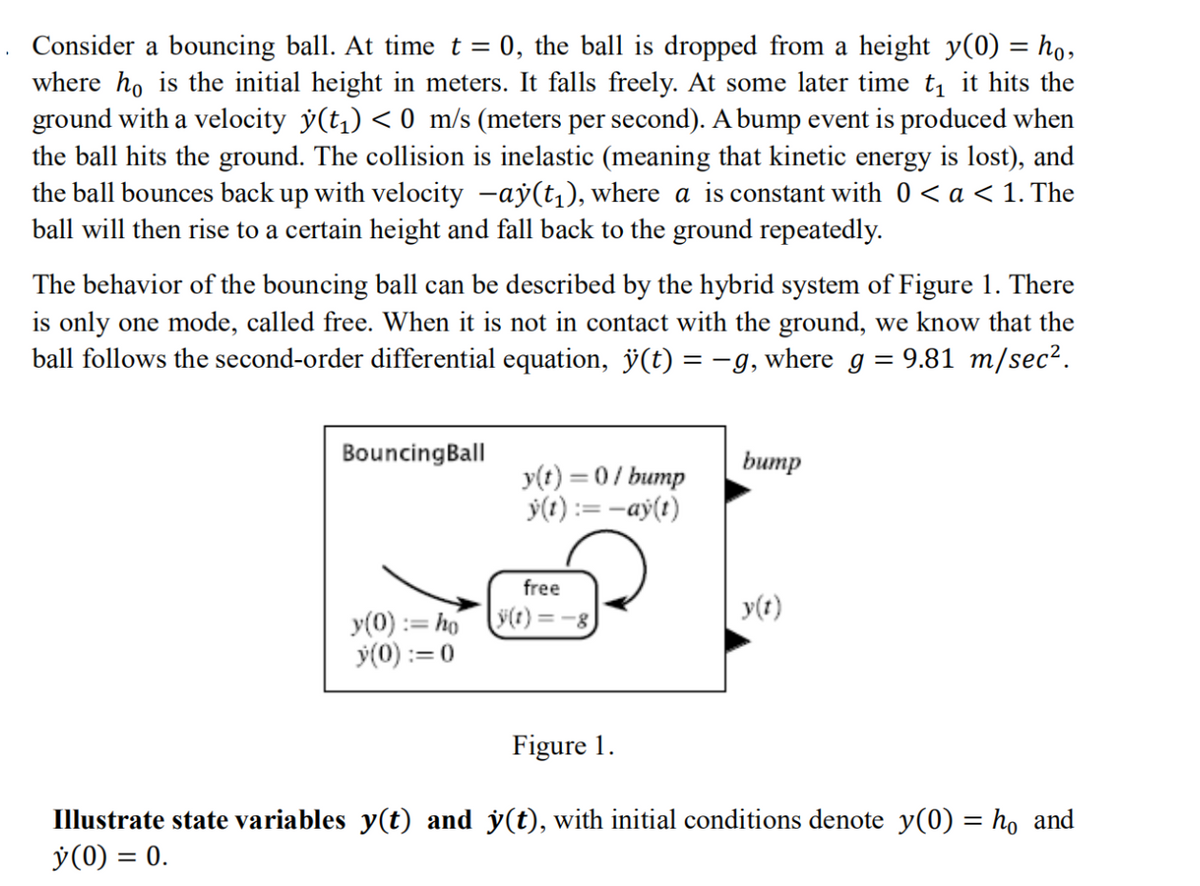Consider a bouncing ball. At time t = 0, the ball is dropped from a height y(0) = ho, where ho is the initial height in meters. It falls freely. At some later time t₁ it hits the ground with a velocity y(t₁) < 0 m/s (meters per second). A bump event is produced when the ball hits the ground. The collision is inelastic (meaning that kinetic energy is lost), and the ball bounces back up with velocity −ay(t₁), where a is constant with 0 < a < 1. The ball will then rise to a certain height and fall back to the ground repeatedly. The behavior of the bouncing ball can be described by the hybrid system of Figure 1. There is only one mode, called free. When it is not in contact with the ground, we know that the ball follows the second-order differential equation, ÿ(t) = −g, where g = 9.81 m/sec².
Consider a bouncing ball. At time t = 0, the ball is dropped from a height y(0) = ho, where ho is the initial height in meters. It falls freely. At some later time t₁ it hits the ground with a velocity y(t₁) < 0 m/s (meters per second). A bump event is produced when the ball hits the ground. The collision is inelastic (meaning that kinetic energy is lost), and the ball bounces back up with velocity −ay(t₁), where a is constant with 0 < a < 1. The ball will then rise to a certain height and fall back to the ground repeatedly. The behavior of the bouncing ball can be described by the hybrid system of Figure 1. There is only one mode, called free. When it is not in contact with the ground, we know that the ball follows the second-order differential equation, ÿ(t) = −g, where g = 9.81 m/sec².
Related questions
Question

Transcribed Image Text:Consider a bouncing ball. At time t = 0, the ball is dropped from a height y(0) = ho,
where ho is the initial height in meters. It falls freely. At some later time t₁ it hits the
ground with a velocity ý(t₁) < 0 m/s (meters per second). A bump event is produced when
the ball hits the ground. The collision is inelastic (meaning that kinetic energy is lost), and
the ball bounces back up with velocity −ay(t₁), where a is constant with 0 < a < 1. The
ball will then rise to a certain height and fall back to the ground repeatedly.
The behavior of the bouncing ball can be described by the hybrid system of Figure 1. There
is only one mode, called free. When it is not in contact with the ground, we know that the
ball follows the second-order differential equation, ÿ(t) = −g, where g = 9.81 m/sec².
Bouncing Ball
bump
y(t) = 0/bump
y(t):= -ay(t)
free
y(t)=-8
y(t)
y(0) := hó
y(0) := 0
Figure 1.
Illustrate state variables y(t) and y(t), with initial conditions denote y(0) = ho and
y (0) = 0.
Expert Solution
This question has been solved!
Explore an expertly crafted, step-by-step solution for a thorough understanding of key concepts.
Step by step
Solved in 3 steps with 3 images
